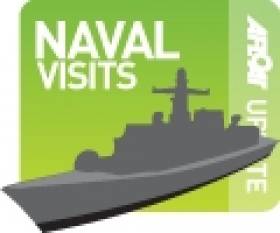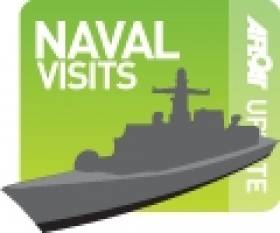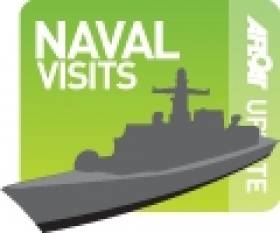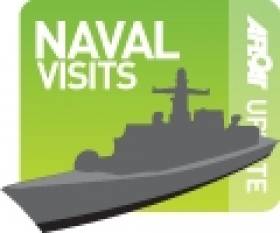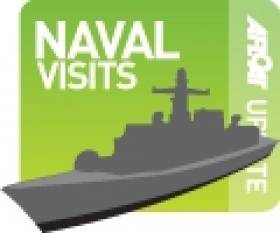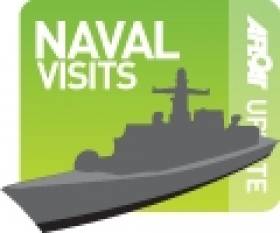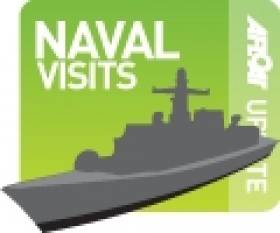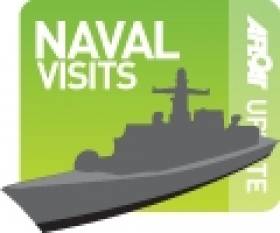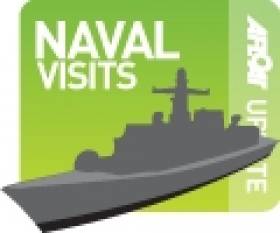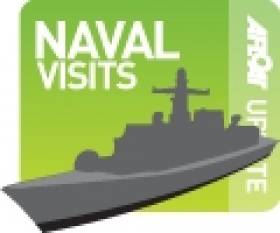Displaying items by tag: Naval Visits
Merkel's Navy Visits Dublin Port for St. Patrick's Weekend
#GermanNavy – Following Chancellor Merkel's recent visit to the European People's Party annual congress in the Convention Centre, Dublin, a German Navy task group are visiting downriver in Dublin Port for the St. Patrick's Weekend, writes Jehan Ashmore.
Among the task force group is FGS Frankfurt am Main (A1412), a Berlin-class group fuel-supply vessel or (AOR) which has already docked this morning.
The AOR (auxiliary oiler replenishment) can also handle containers for military stores, equipment and at the stern is a deck for helicopters.
The 174m AOR berthed at the port's deepwater berth along the south quays beyond the MTL Container Terminal, Ringsend. She has visited the capital before having previously docked also at this berth.
Accompanying the AOR is a flotilla of three ships which will be allocated berths elsewhere on the northern quays. They are the Bremen class frigate FGS Augsberg (F213), the Brandenburg class FGS Hamburg (F220) and the smallest of the three frigates, the Braunschweig class FGS Oldenberg (F263).
As previously reported on Afloat.ie, by our Cork Correspondent, a German Navy sail-training vessel, Gorch Foch is also to pay a visit from today and remaining to 29 March. The three-master of 81m in length will be berthed at Cobh Cruise Terminal.
The crew will be happy to welcome the public for "open ship" events on Sunday, 16 March and Sunday, 23 March, from 2 – 5 p.m. All are welcome, admission is free, no prior registration is required.
French Navy Anti-Submarine Frigate on Visit to Dublin Port
#FrenchFrigate - FS Primauguet (D644), a French Navy 70 class anti-submarine frigate which last month undertook exercises in the Norwegian fjords, docked in Dublin Port for a four-day visit and is understood to be the first foreign caller this year, writes Jehan Ashmore.
The 139metres long vessel commissioned in 1986, has a crew of more than 500 who were deployed in Norwegian waters to operate with corvette Ravera as part of 'Operation Mangoose' .The 30-knot capable frigate's primary arsenal are excocet missiles and she carries up to 2 Lynx helicopters.
She berthed this morning at Ocean Pier, where the frigate is visible to motorists using the East-Link toll-lift bridge and notably can be seen from the Poolbeg Yacht Boat Club with its marina facilities facing the main channel of Dublin Port.
Cork Rebel Week 'Gathers' International Navies
#VisitingNAVIES – More foreign navies continued to gather in Cork Harbour yesterday afternoon to form part of the Cork Gathering Rebel Week which ends tomorrow, writes Jehan Ashmore.
Among the participants of the International Naval Festival are navies from Belgium, France, UK and the Russian Federation which took part in a Fleet Review starting in lower Cork Harbour to Cork City quays. The naval procession was led by the Naval Service flagship L.E. Eithne (P31) which departed Cobh with Minister of Defence Alan Shatter T.D.
His cabinet colleague Minister for Agriculture, Food and the Marine, Simon Coveney had arrived late at the quayside as the L.E. Eithne had to depart on time to lead the review. This resulted in the minister having to hitch a lift from a Port of Cork Company pilot cutter that caught up with the flagship so to enable a transfer onboard.
The naval visitors are docked in Cork City Quays were they will be open free of charge today and tomorrow. So here's a great chance see the array of naval ships and meet the crews.
It would be advisable to confirm the latest updates regarding access to the the naval ships and times (as not all vessels may be open) by visiting: www.corkrebelweek2013.com/
Also taking part in the naval festival albeit moored at the deepwater quay in Cobh is the impressive Russian Navy corvette the RFS Soobrazitelny (531) which only entered service in recent years.
A spectacular Evening Colour Ceremony performed by naval crews in Cork City quays is scheduled for tomorrow (Sunday) at 6:30pm.
Belgium Navy’s Cork Call Joined by UK ‘Duke’ Class Frigate
#VisitngNAVIES – As previously reported the Belgium Navy's minehunter BNS Primula (M924) and auxliliary BNS Stern are visiting Cork which saw today the vessels berth along Cork City Quays, writes Jehan Ashmore.
In addition the Royal Navy's Duke-class frigate HMS Northumberland (F238) is also paying a visit with the 4,000 displacement frigate at anchorage in lower Cork Harbour.
Accompanying the Belgium Navy vessels upriver to Cork City were the LE Eithne and LE Aisling which are berthed nearby.
HMS Northumberland has a crew of more than 185 personnel and along with two of her sisters last month sailed into London to support a variety of maritime events. The 'Northumberland' was present at the inaugural London International Shipping Week conference held in Canary Wharf.
Her sisters HMS Sutherland and HMS Tyne moored at the Royal Docks outside ExCel as part of the DSEi defence and security exhibition, providing delegates with a visible demonstration of naval power and capability.
Belgium Minehunter Visits Cork following call by Dutch Submarine
#MineHunter – Following last week's notable visit of Dutch submarine HNMLS Dolfijn (S808) to Cork City Quays, the Belgium Navy's minehunter BNS Primula (M924) is currently at anchorage in the lower harbour, writes Jehan Ashmore.
Accompanying the BNS Primula is the auxiliary vessel BNS Stern (A963) which is also anchored in Cobh Roads.
BNS Primula is a Tripartite-class minehunter and forms part of the Belgian Naval Component and she has a 595 tonnes displacement. She was launched in 1990 at the Mercantile-Belyard shipyard in Rupelmonde.
The Tripartite class vessel represents the final of ten of the series commissioned for the Belgian Navy. Neighbouring nations Netherlands and France completed the Tripartite partnership in the design and development of the class.
Tripartite class vessels from these nations have been regular visitors to Irish ports unlike the rare sight of a submarine in an Irish port as demonstrated by HNLMS Dolfijn.
The submarine's visit was made more the unusual in that she could be clearly seen moored at the Cork city-centre berth rather than a downriver location which compared to some other Irish ports can be more discreet from public view.
The 'Walrus' class submarine had made the upriver transit of Cork Harbour to the city centre (click previous report and scroll down for footage) and is seen passing near Monkstown.
French F70 Class Frigate to Visit Capital
#FrenchFrigate - Dublin Port is to welcome La Motte-Picquet (D645) a French Navy frigate capable of 30 knots and a crew of more than 230 when she visits the capital next weekend, writes Jehan Ashmore.
Displaceming 4,010 tonnes the anti-submarine Type F70 frigate of the Georges Leygues class is to berth at Ocean Pier during her four-day call.
The 139m long frigate completed in 1985 at the Brest Naval Dockyard, has a comprehensive armament in addition to carrying 2x Lynx Mk 4 helicopters.
Dutch Navy Submarine Visits Cork City Quays
#SUBMARINE – A Dutch Navy submarine HNLMS Dolfijn arrived into Cork Harbour this morning, she is one of four 'Walrus' class which are among the modern sophisticated non-nuclear submarines in the world, writes Jehan Ashmore.
The Royal Netherlands Navy submarine which draws 7.5m draught berthed at Cork City's J.J. Horgan's Wharf which has a 8.8m depth. She is a sister of lead class submarine HNLMS Walrus which visited Dublin Port several years ago.
The class were built using stealth technologies making them invisible and very difficult to detect by ships, aircraft or other submarines when submerged. The submarines can remain submerged for long periods to carry out their missions.
'Walrus' class specifications: Length: 68 m Beam: 8.5 m Draught: 7.5 m Maximum diving depth: > 300 m Water displacement: 2,450 tonnes (surface), 2,800 tonnes (submerged) Propulsion diesel/electric: (3,132 kW) Maximum speed: 11 knots (surface), 20 knots (submerged) Ship's company: 55 Armament: MK 48 torpedoes
Dutch submarines in peacetime duties are used primarily for reconnaissance. During exercises, they are often used as targets for frigates and helicopters.
Should a nation not be cooperating with sanctions imposed by the international community, the submarines can contribute to enforcing the International sanctions. During the NATO Operation Allied Force, HNLMS Dolfijn helped to enforce the embargo off the coast of former Yugoslavia.
Among the other missions the submarines are involved include: collecting intelligence; conducting coast reconnaissance; laying sea mines and putting special forces from the Netherlands Marine Corps ashore.
On overseas deployments, for example HNMLS Dolfijn has patrolled in the Caribbean Sea with calls to the Netherlands Antilles capital of Willemstad.
UK Joint Services Sail-Training Craft Head for Dublin Visit
#AdventureSailing- HMSTC Arctic Express and Discoverer are a pair of UK adventure expedition sail-training craft (STC) for members of the armed forces who are to visit Dublin Port over the weekend, writes Jehan Ashmore.
The vessels are operated by the Joint Services Adventurous Sail Training Centre (JSASTC) which is a sail training establishment situated in Gosport opposite the Royal Navy's premier naval base in Portsmouth.
The mission statement of the JSASTC is "to develop the personal qualities essential to members of the Armed Forces through adventurous sail training in the Service environment".
The purpose of JSASTC is to develop the character and leadership qualities essential to members of the Armed Forces through offshore sailing in the Service environment.
The objectives achieved by providing Sail Training Craft (STC), skippers, instructors, engineering and logistic support and sail training courses is to train personnel of the three armed services so that they are able to support and ultimately lead, adventurous sail training expeditions in service yachts, both in UK and abroad.
An example of an overseas adventure expedition was the deployment of the HMSTC Discover that saw the 22 metre (67ft) sail training craft make passage from Halifax Canada via Greenland crossing the Atlantic to Iceland and Greenland.
From Greenland the vessel sailed to Norway via Jan Mayan. From Tromso she sailed to Bergen via the Lofoten Islands before finally sailing to her homeport of Gosport via Denmark and The Netherlands.
Royal Navy Fast Patrol Boat Visits Howth Harbour
#RoyalNavy - Howth Harbour, synonymous with Asgard's pivotal gun-running role of 99 years ago, is in the present-day a port of call for HMS Charger (P292) a Royal Navy 'Archer' class fast patrol boat, writes Jehan Ashmore.
The patrol cadet trainee boat is powered by two Rolls-Royce turbo engines. Her fleet-mates have previously called to the major Irish Sea fishing harbour with its marina of the Howth Yacht Club.
Another momentous historic event, this time by HMS Charger, took place earlier this summer, as she became the first Royal Navy vessel to visit the quays of Wexford since Irish Independence. The diminutively sized vessel measuring a mere 20m long on a beam of 5.9m was taking part in the second John Barry Maritime Festival.
HMS Archer is based at the Royal Naval Headquarters (Merseyside) and attached to the Liverpool University Royal Naval Unit. She has five full time Royal Navy crew, and sails with a Royal Navy Reserve training officer and a maximum complement of 12 students.
She was commissioned in 1988 and is one of 14 'Archer' class boats that represent the smallest vessels in the Royal Navy fleet.
Her next port of call is scheduled to be Cork city-centre quays with a berth at the North Custom House Quay.
French Navy ‘Tripartite’ Class Vessel to Visit Dublin Port
#FrenchNavy - The French Navy 'Tripartite' class mine warfare vessel Croix du Sud (M646) which has a hull constructed of composite polyester resin is to visit Dublin Port today, writes Jehan Ashmore.
The Tripartite class is a design collaboration of the French, Belgium and Dutch navy's. She displaces 615 tonnes and the vessel entered service in 1986.
Crew complement comprises of 5 senior officers, 32 officers and 12 trainee cadets.
She is scheduled to dock this morning and berth along Sir John Rogersons Quay and this evening be joined by a German Navy sail training vessel, the Asta.

